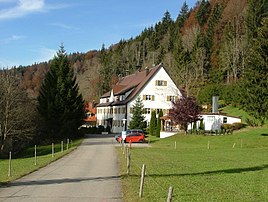Schüttentobel
|
Schüttentobel
Community Grünenbach
Coordinates: 47 ° 37 '12 " N , 10 ° 2' 48" E
|
|
|---|---|
| Height : | 730 m |
| Residents : | 71 (May 25 1987) |
| Postal code : | 88167 |
| Area code : | 08383 |
|
St. Elisabeth retirement home
|
|
Schütte Tobel ( westallgäuerisch Schitt e or Schitt e dobl ) is a hamlet that the municipality Grünenbach in Allgäu belongs. It is located on the community road between Ebratshofen and Sibratshofen . In Schüttentobel the Jugentach flows into the Obere Argen . The hamlet is surrounded by steep, wooded slopes. The place name Schütten tobel comes from the time of iron processing, from the word ore chute.
history
General
Hohenegg Castle was destroyed around 1525. The stones from the castle were later used to build the ironworks.
At the instigation of the mayor of Ebratshofen, Joseph Wiedemann († 1717), a hammer mill with wood grinding, charcoal distillery and large forge was built in Schüttentobel in 1725. The abundance of wood and the existing hydropower favor the settlement. The Schüttenmühle already existed at this time.
The iron processing era ended around 1800.
"Old factory"
Wilhelm Wocher and August Kieser bought a piece of field in Schüttentobel in 1840, Pl. No. 293, in order to set up a knitting factory there. The factory consisted of a machine house that also housed living quarters for the workers. The machine house houses both the mill wheel and a steam engine and later a diesel engine. The steam engine and motor ensure that the factory runs at low tide.
The Löfflund company from Stuttgart began producing milk sugar from whey in 1885. In 1893 the company went bankrupt and production was discontinued. In the meantime, the buildings continued to be used to produce shingles there.
Arnold Brunner set up a wool tear shop in 1924. The factory building burned down in 1931 but was rebuilt.
The Leicher company from Munich relocated production to Schüttentobel in 1943. Ammunition boxes and technical equipment were manufactured for the Wehrmacht.
In 1945 the production of ammunition boxes and technical equipment ended. Furniture was manufactured on the existing machines. In 1950 the factory was finally closed due to lack of renovation.
In 1968 the roof of the factory building collapsed. The Lindau District Office ordered the factory building to be blown up and leveled. Only a small remnant of the west facade of the factory building itself is preserved today. The machine house was converted into a residential building. The remains of the Mühlkanal can still be seen to the west of the building.
Bulk mill
The Schüttenmühle was built in 1749. The date of construction is recorded on the wall clock on the south side of the mill. The mill was known for its good water power, so that you could always work there even in dry summers. The first known owner of the Schüttenmühle was Josef Anton Wiedemann, who was a magistrate and judge in the nearby Hohenegg estate .
The declining grain cultivation and a weir destroyed by floods led to the bankruptcy of the Schüttenmühle under the last Schüttenmüller Eugen Kolb in 1897. The land ownership of the mill for 76 days went to the Baron Nostiz. Ludwig Poschenrieder acquired the mill building itself. The building was used at times as a malt sugar factory, then for milk powder production and finally as a residential building.
The Schüttenmühle had been empty since 2007 and fell into disrepair, around 2010 the building was demolished.
Hohenegg Castle
The Burg Hohenegg was the end of the 12th century by the Lords of Hohenegg built and served as their residence. It was destroyed in the Peasants' War in 1525. Today only a few remains of the wall can be found north of the village.
Architectural monuments
See: List of architectural monuments in Schüttentobel
Leisure and Tourism
The largest tourist attraction is the Eistobel nature reserve , which begins west of Schüttenobel. The horse mountain begins southeast of the hamlet and with the Königsalpe also attracts many visitors.
literature
- Manfred Poschenrieder: Former textile factory Schüttentobel . In: Westallgäuer Heimatblätter . 2003.
- Official directory for Bavaria - territorial status: May 25, 1987 Munich 1991, p. 406.

